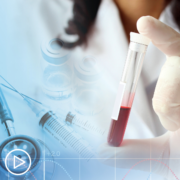How Does the Presence of Molecular Markers Affect AML Care?
How Does the Presence of Molecular Markers Affect AML Care? from Patient Empowerment Network on Vimeo.
Dr. Farhad Ravandi-Kashani reviews how the presence of gene mutations can influence acute myeloid leukemia (AML) treatment choices and discusses new molecular markers being researched for future AML care.
Dr. Farhad Ravandi-Kashani is professor of medicine and Chief of the Section of Developmental Therapeutics in the Department of Leukemia at The University of Texas MD Anderson Cancer Center in Houston, TX. Learn more about Dr. Ravandi-Kashani.
Related Resources:

|

|

|
Transcript:
Laura Beth:
How do test results impact AML care and treatment decisions?
Dr. Ravandi:
So, in the first place, the presence or absence of certain mutations can be predictable outcome. Some subsets of leukemias are, for the lack of a better term, more favorable.
I personally don’t think there is anything favorable about any leukemia, but some are easier to treat, and some are easier to cure than others. There is one specific subtype called acute promyelocytic leukemia that we actually completely treat differently. We don’t use even chemotherapy in that subset of leukemia.
It has almost 100 percent success rate. And the treatment of other subsets can also be tailored, depending on these molecular and chromosomal changes. So, the initial therapy can be actually changed. There are now, for example, targeted agents that can be added to the chemotherapy, during initial chemotherapy.
And also, once the patient is in remission, depending on favorable or unfavorable their leukemia is, they may be offered allogeneic stem cell transplant. So, yes, this information is highly important. In fact, I would say crucial for our decision-making in leukemia therapy these days.
Laura Beth:
So, what is new in AML research related to molecular markers?
Dr. Ravandi:
Well, it depends on your definition of new, but FLT3 mutations are very important because they’re now several FLT3 inhibitors, and as I mentioned, the initial therapies are different, to some extent. The IDH mutations are very important, again, because they are specific targeted agents.
TP53 mutations are important because, unfortunately, they are particularly unfavorable.
This is completely hot off the press, but there are subsets of AML called MLL rearranged leukemias that can respond to these drugs called Menin inhibitors.
There are other mutations that have been discovered, many other ones, that there are no specific treatments for at the moment, but there’s a lot of research on.



